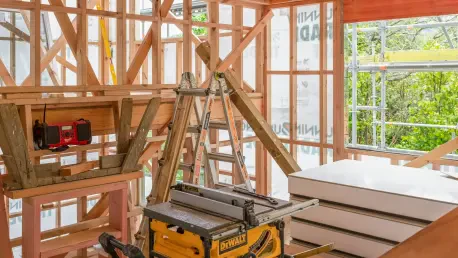The dawn of a new era in home and building automation, driven by Artificial Intelligence (AI), is reshaping how everyday environments interact with their inhabitants. Once limited to simple tasks, automation in homes and buildings is evolving into intelligent ecosystems capable of learning and adapting in real time. The transformative impact of AI extends beyond operational efficiency, heralding a shift toward environments that anticipate needs, manage resources smartly, and enhance living and working conditions through unparalleled personalization. As AI continues to mature, the possibilities seem endless—turning once static structures into dynamic, responsive entities. This revolution is poised to define the next wave of technological advancement, setting new benchmarks for convenience and sustainability.
The Evolution of AI in Automation
The journey of AI from a nascent concept in the 1950s to a fundamental technology shaping home and building automation illustrates its rapid advancement and increasing relevance. Initially conceptualized by pioneers such as John McCarthy, AI now enables devices and systems to function with minimal human intervention. Today’s automation landscape is characterized by intelligent, interconnected systems that not only perform pre-programmed tasks but also analyze data, predict outcomes, and make decisions based on real-time information. This represents a departure from the early stages of home automation, which primarily focused on isolated, programmable devices. AI’s development has reached a level where smart environments become self-sufficient, conserving energy and improving user experience by learning from user behavior and preferences.
This transformation is propelled by the proliferation of IoT devices and the growing capacity to process vast amounts of data quickly. Contemporary smart homes are equipped with sensors and devices that communicate seamlessly, creating a cohesive ecosystem. These devices, empowered by AI, go beyond basic automation by offering advanced functionalities such as energy management and predictive maintenance. For instance, heating systems adjust to the occupant’s schedule, while lighting systems adapt to natural light levels, saving energy and elevating comfort levels. The shift from rudimentary automation to sophisticated, intelligent systems marks a significant milestone in the evolution of AI, underpinning the move toward more efficient and sustainable living solutions.
AI’s Impact on Smart Solutions
The integration of AI into home and building automation is expanding the capabilities of smart solutions by fostering environments that are not just responsive but predictive and adaptable. AI’s impact is evident in the transition from simple automation to environments that anticipate and respond to changes proactively. This advancement is made possible through machine learning algorithms that digest data patterns and enhance the user experience. For instance, AI-driven energy management platforms optimize energy consumption by analyzing user habits and weather conditions. This results in a significant reduction in energy waste, aligning with global sustainability initiatives. The development of voice-controlled interfaces personalized to user preferences further highlights AI’s role in creating intuitive user interactions.
Predictive maintenance exemplifies AI’s transformative impact by foreseeing potential issues before they occur. By integrating AI, systems can analyze data to predict equipment failures, preventing costly repairs and downtime. This capability extends the lifespan of building systems and reduces maintenance costs, benefiting both occupants and facility managers. As AI continues to innovate, the promise of truly intelligent environments becomes tangible, altering how spaces are designed and utilized. This evolution from reactive to proactive solutions redefines building management, emphasizing adaptability and customized living experiences. The ability to forecast needs and address issues preemptively sets new standards for efficiency and tenant satisfaction.
Adapting to AI-Driven Changes
Embracing AI within home and building automation requires adapting to its inherent demands, emphasizing iterative development, robust data management, and ethical considerations in its deployment. The success of AI in this realm hinges on the availability of high-quality datasets, crucial for developing algorithms that underpin intelligent systems. This necessitates partnerships with data-heavy sectors and tech firms actively engaged in AI research and development. Building robust networks with research institutions and companies specializing in AI ensures access to essential resources and expertise, driving forward innovations in smart solutions. Furthermore, as AI continues to shape the industry, fostering a culture of ethical data management is imperative.
A shift in mindset is required to harness AI’s full potential, focusing on transparency and model explainability. Contents of AI algorithms and decisions must be understandable to avoid biases and garner trust among users. The emphasis on open-source approaches and adherence to ethical frameworks mitigates risks associated with AI deployment. These strategies enable a collaborative approach to building sustainable, scalable AI solutions that generate trust and confidence among stakeholders. Organizations facilitating this transition are pivotal, steering industries toward an era characterized by smart, reliable, and efficient automation systems. The journey involves not just technology adoption but a fundamental re-imagination of how spaces are conceptualized, designed, and managed.
Future Implications and Considerations
The evolution of AI from its origins in the 1950s to its role in home and building automation underscores its swift progress and growing significance. Initially envisioned by innovators like John McCarthy, AI now empowers devices and systems to operate with limited human oversight. Today’s automated landscape features intelligent networks that go beyond executing programmed tasks; they also evaluate information, anticipate outcomes, and make choices based on current data. This marks a shift from early home automation that involved isolated, programmable gadgets.
As AI has matured, smart environments increasingly function independently, conserving energy and enhancing user experiences by adapting to user habits. This advancement is fueled by the rise of IoT devices and improved capacity to rapidly analyze vast data sets. Modern smart homes integrate sensors and devices that effortlessly communicate, crafting a unified ecosystem. AI-driven devices surpass mere automation, offering sophisticated functionalities like energy management and predictive maintenance, enhancing both efficiency and sustainable living solutions.









